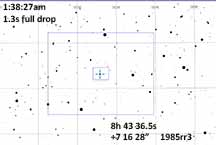

This event is right after the 1999 NU32 event, so swing to new spot must be quick. Take note of any offset from pointing that you had when you acquired the 1999NE32 event, and then look for this new target with that offset. Hopefully you can avoid having to switch in the eyepiece and then back out for the camera. This star is much brighter and should be easy. Odds are only 23% in Santa Cruz though, and lower for Karl.
Alt=36, Az=110 in Cancer
 |
 |
Low odds of 23% for a "hit", but Kirk looks to have lucked out. That makes it likely that I did as well, since we were only 2 miles apart. Karl was too far outside the path, no attempt. I did get the event, but it was only 0.48s and required care to get a 0 false positive.
I observed from my carport, with a very bright annoying new premises night light which may have hurt results. I used 8x, and think is hindsight I should have used 4x to give more points at the minimum and pass the 'red bar' test more easily. The event lasted only 0.48sec, barely passing the FP test and only after trimming the light curve extensively. I did properly do the automatic block integration, and it found the proper 4-block size (8x). Sky subtraction was probably compromised by the environment. The depth should have been deeper that what was seen. I use the TME method. The dip agrees well with the time of the dip seen in Kirk's light curve and I'm convinced it's real. I used the PAL OccBox3.
The PyOTE run showed two "cadence errors", and no missing frames. Both were after the event. I'm not sure what the cadence errors mean. I did notice that the 0.04 second nominal frame interval did make a slow migration in time different from the time stamps. Perfect synch between the camcorder and the Watec would, I assume, not do that, and the exact same fractions of a second would happen after every 25 frames.
magDrop report: percentDrop: 62.8 magDrop: 1.073 +/- 0.618 (0.95 ci)
DNR: 4.20
D time: [09:38:28.9208]
D: 0.6800 containment intervals: {+/- 0.0435} seconds
D: 0.9500 containment intervals: {+/- 0.1094} seconds
D: 0.9973 containment intervals: {+/- 0.2263} seconds
R time: [09:38:29.4008]
R: 0.6800 containment intervals: {+/- 0.0435} seconds
R: 0.9500 containment intervals: {+/- 0.1094} seconds
R: 0.9973 containment intervals: {+/- 0.2263} seconds
Duration (R - D): 0.4800 seconds
Duration: 0.6800 containment intervals: {+/- 0.0667} seconds
Duration: 0.9500 containment intervals: {+/- 0.1516} seconds
Duration: 0.9973 containment intervals: {+/- 0.3042} seconds
 |
 |
 |
 |